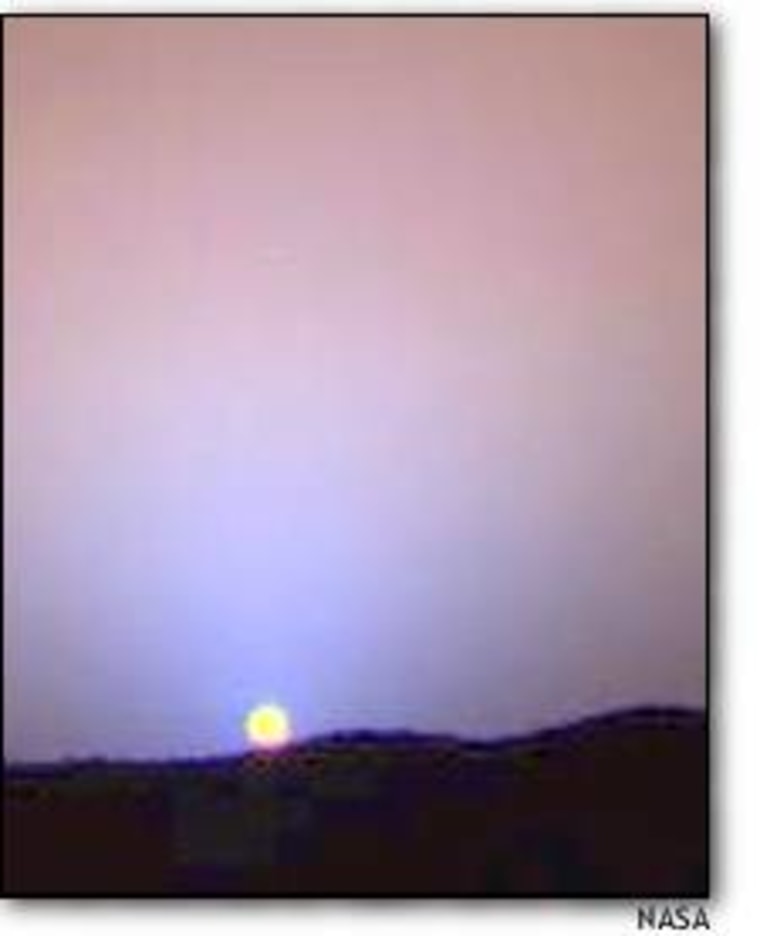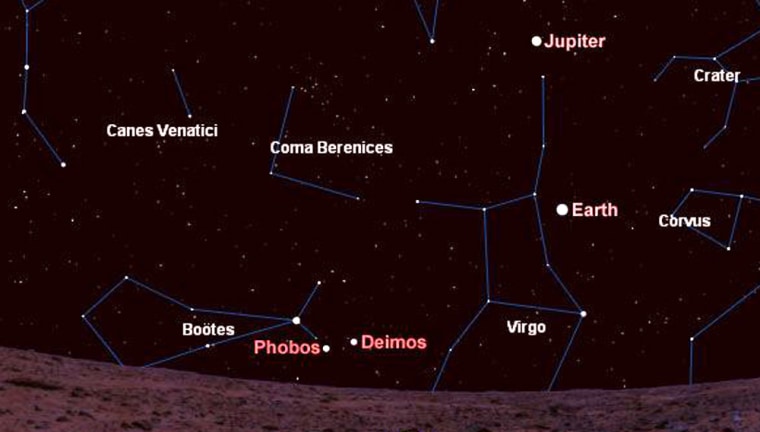To see the surface of Mars, we rely on robots as our virtual eyes. To see the Martian night sky, we need a computer program.
With the help of astronomy simulation software such as , earthlings can take a virtual journey to Mars. Our chosen landing spot in the simulated view shown above is Gusev Crater, the expected landing site of NASA's Spirit rover, one of two probes the agency has arriving in January.
From here we can gaze into the Martian sky and see distant stars and not-so-distant planets, things surprisingly familiar and things utterly strange.
Familiar night
Mars is remarkably similar to Earth in its rotational rate, which determines the duration of day and night.
Mars rotates a tad slower than Earth, giving rise to a Martian day of 24.6 Earth hours compared to the 24 we're used to. So on Mars you would have a just a slightly longer nighttime observing window, as compared to someone back home, and the stars and constellations would move across the sky at about the same rate.
Both planets have a similar axial tilt, the inclination of a world's rotational axis relative to the plane of its orbit around the sun, called the ecliptic.
Earth is tilted 23.5 degrees, and Mars tilts 25.2 degrees. As on our planet, this tilt causes seasons on Mars. Terrestrial seasons are associated with certain constellations and stars. Because a Martian year — the time it takes to make a complete revolution around the Sun — is nearly twice as long as Earth's, the seasons on Mars are twice the duration.
Better viewing conditions
Mars is a cold, dry place with a thin atmosphere. That's good for backyard astronomy.
An atmosphere is like an ocean of air. Light from celestial objects must penetrate air to reach the surface. Along the way, the light can be bounced around slightly by pockets of air that are ofdifferent temperature and density. This is what makes stars twinkle.
The Martian atmosphere is so thin — about 1 percent as dense as Earth's — and the temperatures so frigid that observing from Mars must be akin to observing from space, from where stars don't twinkle.
Transparency and seeing, two factors that are key in choosing a location for a professional observatory, are better at the surface of Mars than on the highest mountain on Earth.
The conditions would allow the average human eye to see celestial objects down to magnitude 6.6 or so during a clear night free of low-level clouds or Martian dust storms. On used by astronomers to denote brightness, lower numbers are the brightest, and negative numbers are the brightest of all. Magnitude 6.6 is about the same as what is ultimately possible on Earth. But here there is so much light pollution, from cities and even rural streets and porches, that few viewers achieve totally dark skies.
On Mars, as far as we know, there are no metropolitan areas.
Familiar stars
If you set up your telescope around sunset on Mars, the sky would gain a pinkish cast, caused mainly by the scattering of reddish dust particles suspended in the lower atmosphere. As the sun sets and night takes over, the brighter stars begin to make their entrance and slowly form familiar patterns of the constellations.

Perhaps surprisingly, you note that the stars create the same patterns from Mars as they do from Earth. This is because stars are very far away, so that from our perspective within the solar system, they appear to be in the same location in the sky relative to each other. Stars also have the same apparent brightness as they do when viewed from the Earth. For example, Sirius is still the brightest star in the sky.
The Gusev Crater is 15 degrees south of Mars’ equator. From here, looking towards the eastern horizon is Orion the Mighty Hunter, and to its left Taurus the Bull.
Moving to the southern horizon is Vela the Sail, Crux the Southern Cross, and Carina the Keel, whose star Canopus is the second brightest star in the whole sky.
Towards the west would be Sagittarius the Archer; Corona Australis, the Southern Crown; and, lurking just above the horizon, the sting of Scorpius the Scorpion.
In the north is Pegasus the Winged Horse and Andromeda the Princess. Stars from these two constellations form the easy-to-recognize Great Square of Pegasus.
Looking back home
While stars are in familiar positions, planets are another story.
Earth is the most notable difference. In fact, Earth is one of the brightest objects in the Martian night sky, outshining all stars at about –3 magnitude when Earth and Mars are at their closest.
The pale blue glow of Earth is surpassed only by Venus, which although further away from Mars than Earth on average, still manages to outshine it due to its highly reflective atmosphere.
Earth's moon, at about magnitude 0.9, would also be visible without optical aid. That's a level of brightness equal to many obvious stars. However, the moon never wanders far away from Earth, for a Martian observer, making it difficult to discern at times amidst the brighter glow of Earth.
Two Martian spacecraft — Mars Express and Mars Global Surveyor — have looked back to photograph Earth and its Moon.
A small telescope would resolve Earth into a disk rather than just a point of light. Your telescopic view would show you that the Earth exhibits phases — just as Mercury and Venus do when observed from the Earth.
Careful observation or imaging of the Earth would reveal clouds and the outline of the major continents. It would be difficult to see details on the moon other than the contrast between darker and lighter areas. Absent would be the many craters so readily seen from Earth.
During the week of the scheduled landing of the Spirit rover, Earth and the moon can be seen rising low in the eastern Martian horizon two hours before sunrise in the constellation of Virgo. Earth is a "morning star" – a term used to describe Venus when it is in Earth's morning sky (right now from Earth, Venus is the "").
Above Earth and slightly to the left is Jupiter, bordering on the western edge of Virgo. A simple pair of binoculars would reveal its four largest moons.
here is one other dramatic and unmistakable difference in the night sky of Mars.
The Red Planet has two tiny moons. Both were discovered by Asaph Hall in 1877 and named after Mars' mythological attendants: Phobos (Fear) and Deimos (Terror). Unlike Earth’s moon, Phobos and Deimos are irregular potato-shaped satellites that might be captured asteroids.
Phobos and Deimos are much closer to Mars than the moon is to Earth. Phobos orbits Mars from about 5,830 miles (9,380 kilometers), on average, and Deimos is about 14,570 miles (23,450 kilometers) from the planet. Earth's moon is roughly 238,900 miles (384,402 kilometers) away, on average.
hobos, the larger of the two Martian moons, is a mere 14 miles (23 kilometers) across its largest dimension. Due to its proximity, though, from Mars it looks about one-third as big as Earth’s moon looks from home. Even if you stepped casually out of your Martian hut, you could find the moons with your naked eye. But both are much darker than the Earth’s moon, due to their darker surface materials, which reflect less light.
On Earth, a full moon is so bright in the sky that it significantly lowers the number of celestial objects that can be observed. The Martian moons do not affect the night sky nearly as much.
Phobos merits special attention. It orbits Mars about once every seven hours, much faster than Mars' rotation. Phobos rises and sets in about 4 hours. It would rise again about 7 hours later.
Another consequence of the great speed of Phobos is – more than
Slower-moving Deimos orbits Mars in about 30 hours, and its motion in the sky is hard to notice.
Surface images of Mars during the daytime should soon be getting beamed back to Earth regularly. For views of the night sky, perhaps humans will have to venture there.
